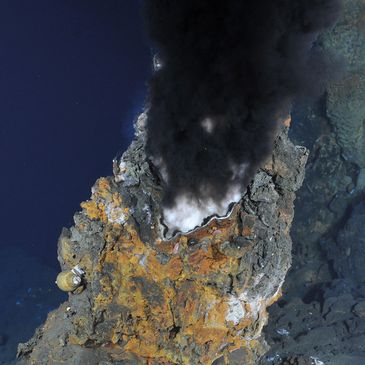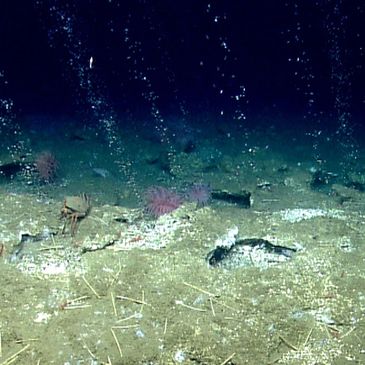Hydrothermal Vents and Cold Seeps

Black Smoker
Black Smoker
Black Smoker
Black smoker hydrothermal vents emit high-temperature fluids that precipitate sulfides as they exit the seafloor.

White Smoker
Black Smoker
Black Smoker
White smoker hydrothermal vent fluids mix with seawater before exiting the seafloor, depositing minerals in the crust.

Clear Fluids
Black Smoker
Clear Fluids
Hydrothermal vents with clear fluids indicate more subsurface seawater interaction and are sometimes cooler.

Cold Seeps
Black Smoker
Clear Fluids
Cold seeps occur as gases formed from the decomposition of organic matter escape the seafloor.
Vents and Seeps
Oases of deep-sea life
Hydrothermal vents and cold seeps are deep-sea ecosystems that are powered by chemotrophy. Hydrothermal vents form near areas of seafloor spreading or at hotspots. These regions have hot magma rising up to shallow depths in the crust, and circulating seawater heats up. All that hot seawater in the rocks strips them of minerals, which precipitate out in the crust or outside the crust as the water cools. All of these interactions provide loads of chemical energy for vent ecosystems, which depend on chemotrophic bacteria as the base of the food web. At cold seeps, very different processes are occurring that are more related to transformations and movement of organic material within the crust. Cold seeps are common along continental margins and ancient inland seas like the Gulf of Mexico. Similar animals live at seeps and vents which is likely due to the relationships of these animals with their endosymbiotic bacteria.

SDSU Geology
CHEMOTROPHY
What is chemotrophy?
Chemotrophy refers to the source of energy that organisms use to power their cells. In this case, it is energy gained from chemical reactions. Chemotrophy is often used in habitats where there is no sunlight for phototrophy, or the use of light energy to power cells. Deep-sea ecosystems use chemotrophy, rather than phototrophy, since there is no sunlight.
The chemical reactions that power chemotrophy in these ecosystems usually involve sulfur, iron, hydrogen, and oxygen. These elements are abundant at the seafloor due to seawater (and oxygen) reacting with rocks in the seafloor. In the case of hydrothermal venting, these reactions occur at very high temperatures, which strips the rocks of elements. These elements are precipitated as the fluid cools, either inside or outside of the crust.
Chemotrophy in cold seeps is similar to vents, but there is usually more carbon available like methane and other hydrocarbons.

Biology of Vents and Seeps
Bacteria
Crustaceans
Tube Worms

Bacteria that oxidize sulfur and methane are common chemotrophs at hydrothermal vents and cold seeps. Sulfur oxidizers are endosymbionts of many vent animals.
Tube Worms
Crustaceans
Tube Worms

Tube worms have endosymbiotic bacteria in their tissues. They provide sulfide, orxygen, and carbon to the bacteria and in return the bacteria give them sugar for food.
Crustaceans
Crustaceans
Pompeii Worms

Vent shrimp have symbiotic bacteria in their gills. They also have a light-sensing patches on their backs that detect infrared light emitted from hot vents.
Pompeii Worms
Mussels and Clams
Pompeii Worms

Pompeii worms can withstand some of the highest temperatures of any animal.
Mussels and Clams
Mussels and Clams
Mussels and Clams

Mussels and clams have two endosymbionts that can use either methane, sulfur, or hydrogen.
Snails
Mussels and Clams
Mussels and Clams

Snails like this scaly-foot snail have endosymbionts and form pyrite (fool's gold) on their shells and foot.
Image Credits
Black Smoker - GEOMAR/Schmidt Ocean Institute/CSSF
White Smoker - NOAA Okeanos Explorer Program
Clear Fluids - NOAA/Chris German (WHOI)
Cold Seeps - NOAA
Hydrothermal Vent Diagram - SDSU Geology
Tube Worms - NOAA
Vent Shrimp - Magali Zbinden
Pompeii Worms - Bir et al., 2020
Mussels and Clams - Hashimoto et al., 2007
Snail - David Shale
This website uses cookies.
We use cookies to analyze website traffic and optimize your website experience. By accepting our use of cookies, your data will be aggregated with all other user data.